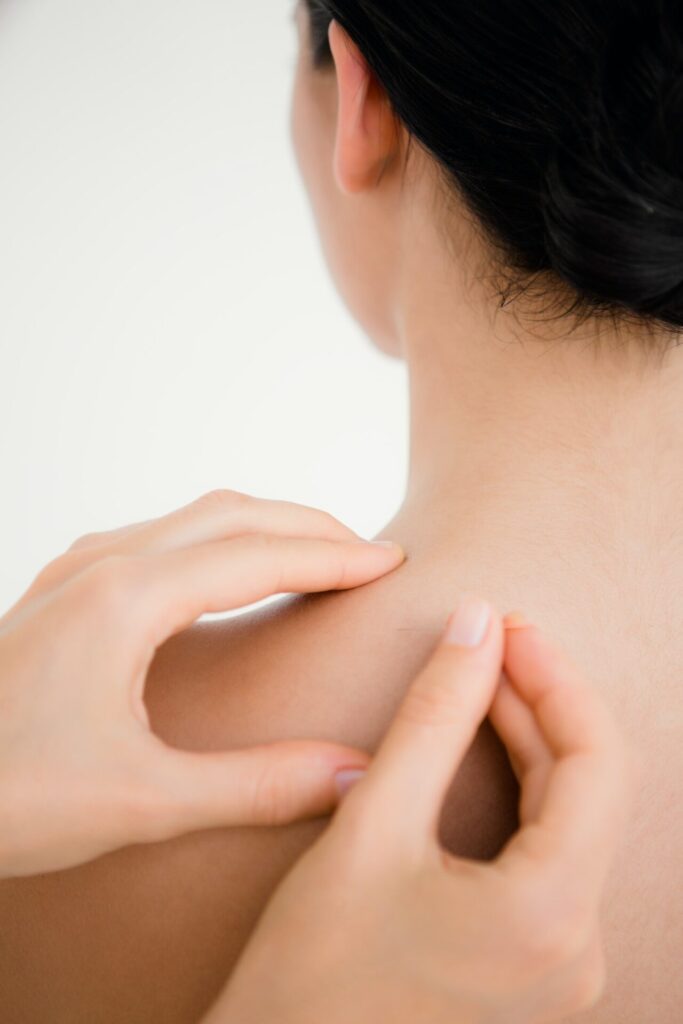Acupuncture is a traditional Chinese medical practice that involves inserting thin needles into specific points on the body to stimulate various physiological responses. It has been used for thousands of years and is often employed as a complementary or alternative therapy. While acupuncture may not be suitable for all medical conditions, it has demonstrated effectiveness for a range of ailments. Here are some features, benefits, and considerations associated with acupuncture: Features of Acupuncture:
- Needle Placement: Acupuncture involves the insertion of very fine needles into specific acupuncture points along the body’s meridians or energy pathways. The depth and location of needle insertion vary depending on the condition being treated.
- Holistic Approach: Traditional Chinese medicine views acupuncture as a way to balance the body’s vital energy, known as Qi (pronounced “chee”). It aims to address the root causes of health issues rather than just alleviating symptoms.
- Minimal Discomfort: Acupuncture needles are extremely thin, typically causing minimal to no pain during insertion. Patients often report a sensation of tingling, warmth, or dull pressure at the needle sites.
Benefits of Acupuncture:
- Pain Management: Acupuncture is widely recognized for its effectiveness in relieving various types of pain, including chronic pain conditions like back pain, osteoarthritis, migraines, and menstrual cramps.
- Stress Reduction: Many people find acupuncture to be a relaxing experience that reduces stress and anxiety. It may also improve mood and sleep quality.
- Enhanced Well-being: Acupuncture can contribute to an overall sense of well-being by improving energy levels, digestion, and immune function.
- Complementary Therapy: Acupuncture is often used alongside conventional medical treatments to enhance their effectiveness and reduce side effects. For example, cancer patients undergoing chemotherapy may use acupuncture to manage nausea and pain.
Conditions for Which Acupuncture May Be Used: Acupuncture is considered for a wide range of conditions, including but not limited to:
- Pain management (e.g., back pain, knee pain, migraines, and fibromyalgia).
- Gastrointestinal issues (e.g., irritable bowel syndrome and nausea).
- Respiratory disorders (e.g., asthma and allergies).
- Mental health concerns (e.g., anxiety, depression, and insomnia).
- Women’s health issues (e.g., menstrual disorders and fertility).
- Neurological conditions (e.g., stroke rehabilitation and neuropathy).
Frequency and Duration of Acupuncture Treatments: The frequency and duration of acupuncture treatments can vary depending on the individual, the condition being treated, and the practitioner’s recommendations. Here are some general guidelines:
- Initial Course: Typically, an initial course of treatment may involve one to two sessions per week for several weeks. This allows the acupuncturist to assess progress and adjust the treatment plan as needed.
- Maintenance: After the initial course, some individuals continue with maintenance treatments, which may be less frequent, such as once a month. Maintenance sessions can help sustain the benefits achieved during the initial course.
- Individualized Approach: The number of sessions required can vary widely. Some people experience significant improvement after just a few sessions, while others may require ongoing treatment for chronic conditions.
- Consult with a Practitioner: It’s essential to consult with a qualified acupuncture practitioner who can provide personalized recommendations based on your specific condition and needs.
In Australia, acupuncturists typically need to meet certain educational and registration requirements to become qualified and practice legally. The qualifications and regulations for acupuncturists can vary slightly from state to state, but there are some general steps that individuals must follow to become qualified acupuncturists in Australia:
- Education: Acupuncturists in Australia must complete a nationally accredited acupuncture program. These programs are typically offered at the bachelor’s or master’s degree level and are available at various universities and private institutions. It’s important to choose a program that is accredited by the Chinese Medicine Board of Australia (CMBA).
- Coursework: During their acupuncture education, students will study topics such as traditional Chinese medicine theory, acupuncture techniques, herbal medicine, anatomy and physiology, pathology, clinical diagnosis, and practical skills in acupuncture and needling.
- Clinical Experience: Students are usually required to complete a certain number of clinical hours under the supervision of experienced acupuncturists as part of their training. This hands-on experience is crucial for developing practical skills and gaining real-world experience.
- Registration: After completing their education and clinical requirements, individuals can apply for registration with the Chinese Medicine Board of Australia (CMBA). To be eligible for registration, they must meet specific competency standards set by the CMBA. This typically includes passing an examination administered by the Australian Acupuncture and Chinese Medicine Association (AACMA).
- Continuing Education: Acupuncturists are required to engage in ongoing professional development and continuing education to maintain their registration. This ensures that they stay up-to-date with the latest developments in acupuncture and Chinese medicine.
- State-Specific Requirements: Some states in Australia may have additional requirements or regulations for acupuncturists. It’s important to check with the relevant state health department or regulatory body for any additional requirements or licensing processes that may apply.
- Insurance: Acupuncturists are also advised to obtain professional indemnity insurance to protect themselves and their clients in case of any adverse events or legal issues.
- Membership in Professional Organizations: While not a strict requirement, many acupuncturists in Australia choose to join professional organizations like AACMA to access resources, networking opportunities, and support in their practice.
How to Book an Appointment
Please follow the Book online button to book a time or check availability. Alternatively please text Tanya Galvin 0408 054 538.
The clinic was located at 111-113 McManus street Whitfield, Cairns, 4870.
The clinic is now located at 12 Scott Street Parramatta Park, Cairns, 4870.
It’s in a Queenslander and the entrance if via the front door (downstairs). There is an intake form to fill in in the foyer.
Please note there is a 24 hour change or appointment or cancellation or no show policy.
The full Fee applies. www.cairnsmassage.net.au or www.portdouglasmobilemassage.com.au or www.mobilemassagecairns.com.au or dryneedlingcairns.com.au
